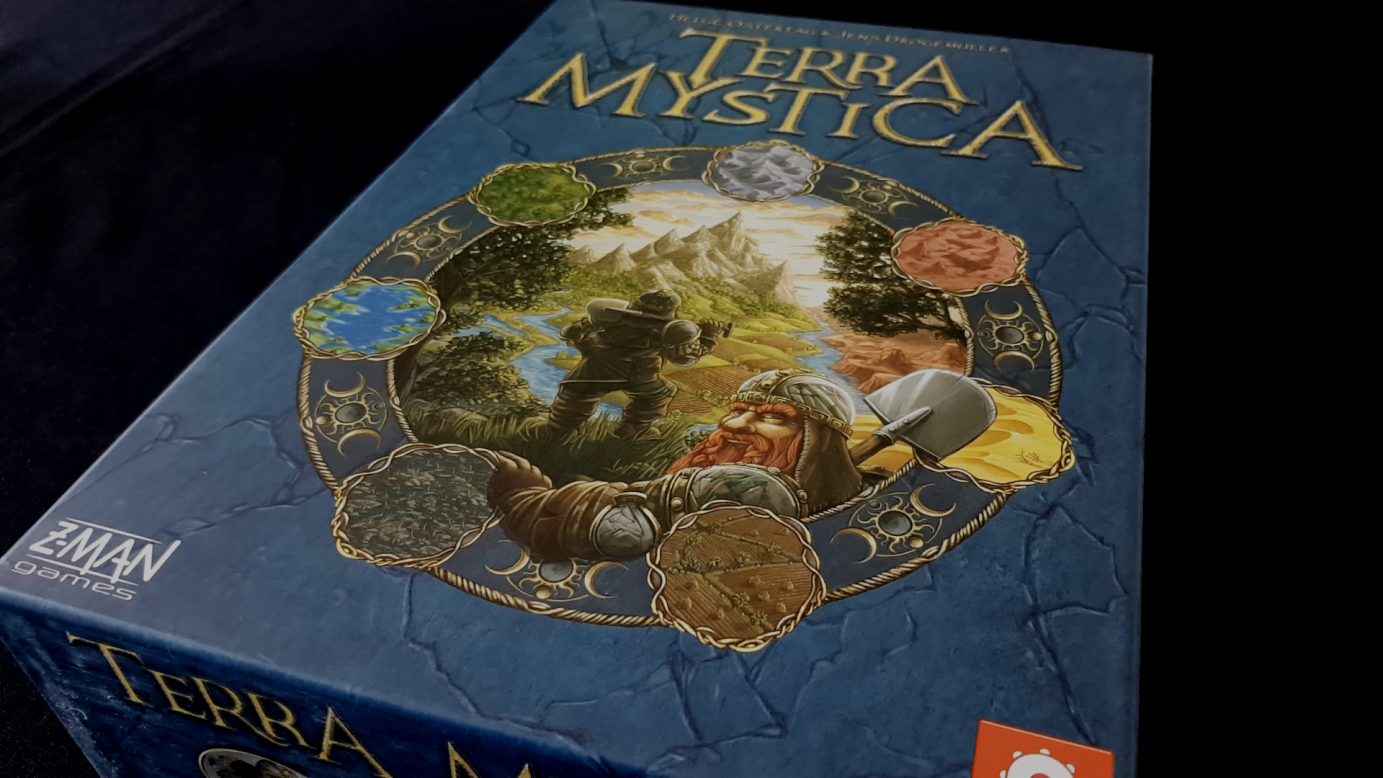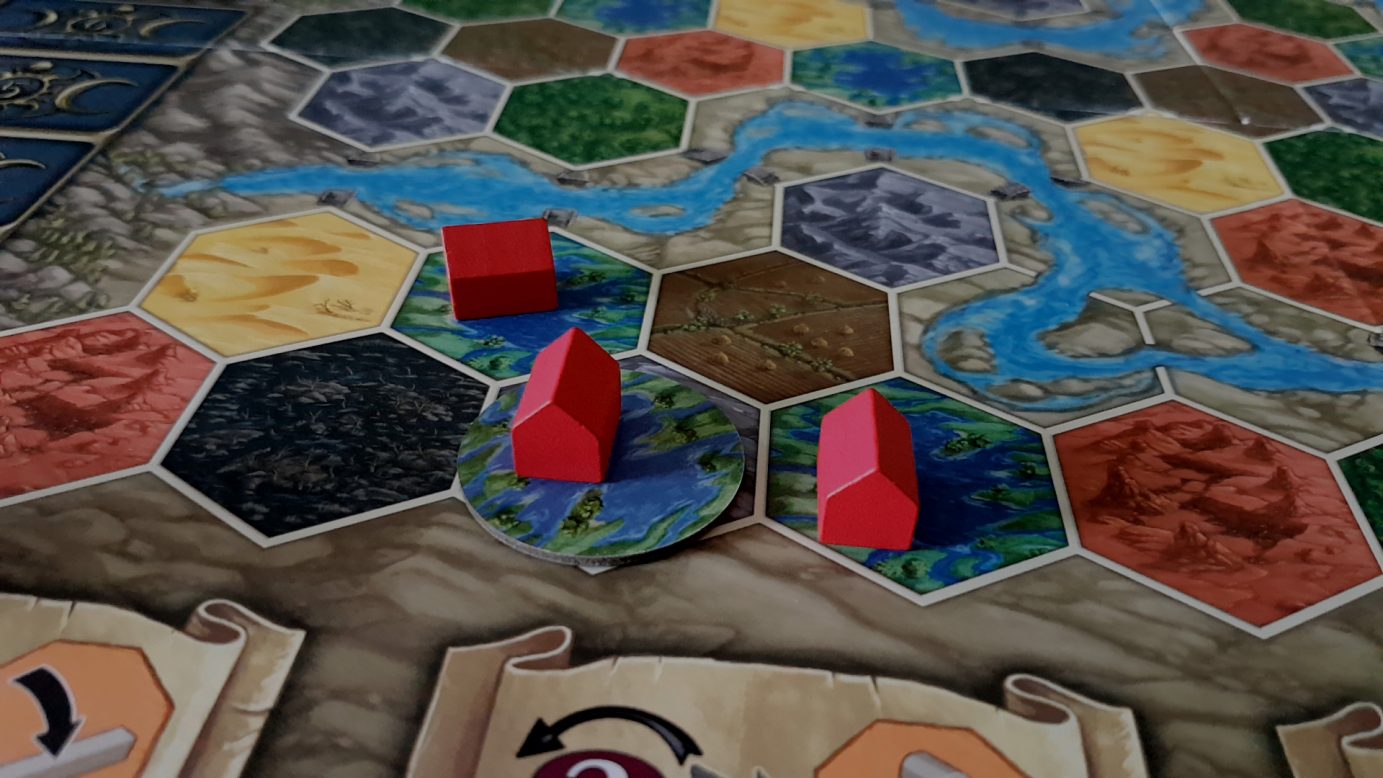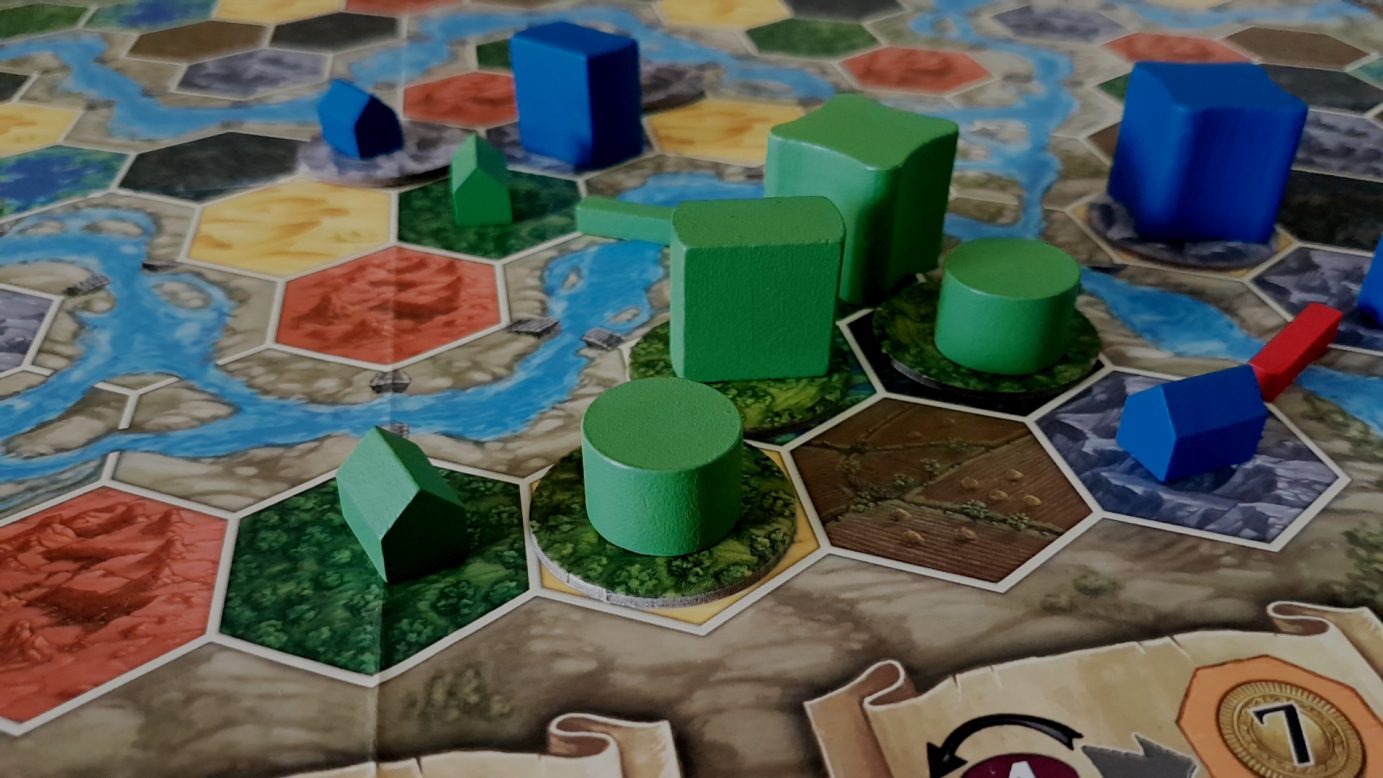| Game Details | |
|---|---|
| Name | Terra Mystica (2012) |
| Accessibility Report | Meeple Like Us |
| Complexity | Medium Heavy [3.97] |
| BGG Rank | 30 [8.06] |
| Player Count | 2-5 |
| Designer(s) | Jens Drögemüller and Helge Ostertag |
| Buy it! | Amazon Link |
There’s a risk for this site that comes with starting a review of Terra Mystica. It’s a game that you could legitimately discuss for tens of thousands of words, being reviewed by someone that views academic essays as something akin to a post-it note of brief reminders. I’m going to make a Herculean effort here not to go on and on and on but let’s be honest – precedent is not on either of our sides here.

Terra Mystica has been on my review pile for a long, long stretch of the site’s existence. I’ve played it dozens of times but never to the point that I felt I had nothing left to learn. A common criticism aimed at reviewers is that they don’t give a game enough time in front of them before rendering a judgement and I’ve always been sensitive to that. My long-form thoughts on play counts has been published elsewhere on the site but it really boils down to ‘You’ve played a game enough to review it when it has nothing new to show you’.
I’m not really sure that point exists for Terra Mystica. Even with the many times I’ve played it through I don’t feel like I’m even competent at the game. It’s overwhelming – a game of undeniable depth and complexity that requires you to approach it anew with every fresh starting configuration. It’s also a genuinely great game where it’s easy to enthuse upon its remarkable design. Just bear in mind – this is a game that is going to ask a lot from its players.

I’m not even going to attempt to summarise the rules here. There are too many interlocking systems for that to be a worthwhile endeavour. Instead, I’ll group the gameplay into a series of themes – broad goals that you’re looking to accomplish through the mechanisms of the rule-set.
The first of these is area dominance. The base box of Terra Mystica comes with fourteen factions, each of which is defined by their favoured terrains; the costs they incur when performing particular actions; number of starting settlements and so on. They each also have a special power that will be unlocked later as their controlling player builds a stronghold somewhere on the map. Part of the job of a player here is to claim the best terrain, and terraform unsuitable terrain into that which is suitable. This requires ‘shovels’ and the sheer physical grunt-work implied by the expending of worker cubes. Matching terrain to faction needs is important because it allows the building of dwellings, and these can later be upgraded into trading posts that generate money and temples that generate power and priests.

Power in Terra Mystica passes inexorably from a series of mystical bowls into various levels of potential. You’ll gain power for a number of things during play, and every time you gain a power cube you displace existing power into increasingly purer bowls. If you gain three power, that refines power from your lowest bowl into the next higher. You can safely spend power from the third bowl to take special power actions – they let you summon workers, priests, money and so forth into your faction. Those safely spent power tokens rotate back into bowl one for the cycle to begin again. If you don’t have enough power to meet the demand you need to permanently sacrifice power tokens to make up the difference. Mana management thus is an important part of the game, requiring you to plan ahead and make difficult decisions about whether your long or short term goals are best met by losing future raw potential.

Running somewhat parallel to the mana aspects of the game is the cult system – priests you earn can be spent upgrading various abilities of your faction but they can also be spent to progress along one of the four cult tracks. The players in the highest position on those tracks will earn points at the end, as well special bonuses determined by the scoring tile…
Oh god, the scoring tiles. Yes.

Scoring tiles are dealt out from a subset of the full box at the start of each round and give round-specific requirements for earning points. You might get these points for building dwellings, trade posts or sanctuaries. Maybe you’ll get points for using a spade to terraform, or for founding a town…
Did I mention towns? Oh no, I didn’t. You found a town when you have at least four connected structures with a combined power value of seven. At that point you get a Town tile that gives you a special bonus which will usually include the key that’s needed to unlock the highest echelon of the cult track. It’s not a bad idea early on to take the bonus card that are most compatible with earning this preferment…
Oh yes, bonus cards. Each round continues until someone passes, at which point they have the first pick of the available bonus cards in play. These give a round-long benefit that will offer money, power, workers or additional opportunities that are unavailable to others. When combined with the right favour tiles these can lead to very powerful combinations.

I talked about favour tiles, right? No? Oh my god. Well, you get favour tiles when…
Actually let’s cut it short here. Suffice to say the rule-book is 20 pages long and any one page is going to have a dozen sections each of which will likely outline one or more rules of varying specificity. It’s a complicated game that is exhausting to learn to the point you’re not just taking random actions with random consequences.
What I’m mostly trying to provide here is a sense of the number of systems you’ll need to master and leverage through play. Importantly there are only six rounds in Terra Mystica and each one is characterised by economical decisions that can best be described as brutalizing. You never have enough to do as much as you like, and usually in order to build up a sustainable pool of income you’re going to have to sacrifice important scoring opportunities. Earlier rounds have consequential outcomes far beyond what they immediately enabled. Whether you succeed or fail is often decided in the first two rounds, and that can be uncomfortable when you know that you’ve planted the seeds of your own chronic irrelevance into the soil of the board. Often you’re left shell-shocked at the sheer number, and impact, of the options you have to consider at any one time.

This more than anything else is what characterises Terra Mystica for me. If it were the only game I owned I would likely find myself forever enchanted by the optimisation puzzle it presents to the player. If I were stuck on a desert island for twenty years, it’s a game I’d certainly want to be in the game library I set up beside the coconut groves. I would take it in preference to a couple of dozen of the games we’ve spoken about here on Meeple Like Us. It feels like it has fathomless depths within its cardboard and you don’t often get that in hobbyist games.
But the counterpoint of that is – realistically how often are you going to play Terra Mystica? If the answer is anything less than a few dozen times I’d argue you may as well not bother. It’s too reluctant – too opaque – to offer up its most succulent prizes to an indifferent dilettante. This is a game you dive into headfirst and with passion or not at all. At least if you’re interested in adding more than a bafflingly incoherent cube-pusher onto your shelves.
That’s somewhat unfair, but I think you grow into Terra Mystica rather than instantly find yourself in its clutches. The different factions have their own massive learning curves, and the random setup at the start of the game limits which scoring tiles and bonus cards will be available. Every single starting configuration carries within it an almost unbearably smug challenge. ‘What are you going to do now, smartypants?’ it asks.
There are three answers there.
If you’re new to the game you’re going to run the risk of your brain saying ‘Haha, you’re on your own’ and shutting down for a bit. The possibility space isn’t just large – it’s intimidating in the vastness of its cold expanses. Everything from where you place your starting settlements to which bonus cards you take to which scoring card is in effect for this round creates complexities within complexities before you even start to plan out your strategy. What you’re almost certainly going to do is move a few things around and then find out that you’re left cursing the scant options your earlier incompetence left you. The game simultaneously opens up its economy and shuts down your opportunities as it goes on. You often find the last round of the game hits you quicker than the pace for which you were remotely prepared. I think you’re likely to come away largely (terra) mystified. Early experiences of Terra Mystica are often bound up in the sense that you’re playing something weirdly incoherent and disjointed. It’s almost passive aggressive in the way it presents the challenge of optimising its internal economies. It starts off so sluggishly and has an ending that will have such a degree of accumulated momentum that it will take your head clean off.

If you’re less new to the game you can probably muddle through and come up with a decent engine that balances all your competing responsibilities. That’s where I am on the Terra Mystica skill curve. The thing about running a blog like this is that you only occasionally really get the time to master a game and I’m nowhere near that stage. I suspect I never will be. My level of skill though is enough to move my grinding wheels of appreciation of the game into a higher gear. The more you play the easier it becomes to see the subtle interconnectedness of the systems. Don’t get me wrong – it still feels like everything is perhaps 20% more complicated than it needs to be and is 10% less interconnected than it should be. It comes together more elegantly the more you play, but never with the smoothness that you would get with less arcane rule design. For example, for all the interesting emergent behaviour you get from the mana bowl system I’m unconvinced it’s any better than just giving players a few cubes to spend here and there. It’s a clever mechanism that makes the game feel smarter but doesn’t really feel like it makes the game better.
At my level of mediocre performance Terra Mystica becomes something like Frankenstein’s Monster version 2.0. You can see it’s stitched together from monstrous and ill-fitting parts but most of the kinks have been ironed out and it turns out to be a good deal more agile than you might have been expecting from the bolts through its neck. It becomes more like a kind of cardboard MONIAC – operating your faction becomes a frantic job of squeezing valves and turning nozzles until everything flows the way it should. It evolves to be a game of imposing your own will on a recalcitrant game-state that dribbles and drizzles out of your grasp. It’s not so much an engine builder as an exercise in balancing fluid dynamic equations under unfortunate circumstances.
If you’re an old hand with the game though, well – things get different still. Terra Mystica – like Chess, like Twilight Struggle – is a game sufficiently open to theorycrafting that it now has a compelling library of opening moves and fixed strategies. That’s always a great sign that a game has sufficient cleverness in its design to warrant such considerations but it always strikes me as a touch ossified. A lot of the energy and vigour of play is lost when it becomes a case of learning the ritualistic rites and faction interrelationships. It becomes homework, at least for me. But in that you also probably see Terra Mystica reach its apotheosis as a design – a game of precise strikes at precise times where energy conservation and follow-through positioning is far more important than any of the more obviously impactful systems with which you tinker.
Terra Mystica has shades of Race for the Galaxy in how I describe it to people. It’s a game I enjoy playing but a game I’d never want to be in the position of teaching or playing with people of substantively different skill levels. I just feel bad playing it against new people and it feels bad for me to play it against people that know what they’re doing. The incompetence of my opponents must be roughly approximate to my own. It’s one of a number of games that are best defined by the chilly lack of forgiveness – for the lack of mercy – they have built into their mechanisms. For all its art and pretense of thematic trappings it’s easily the least whimsical game I own. I shouldn’t end a play session of a game feeling judged by the design, but I do. For a game that is so obviously over-engineered it’s a shame nobody found room for fun in the box.

Ooft, that’s harsh, so let me roll back.
I don’t think of Terra Mystica as a fun game. If I’m looking for a good time it’s not even on a short-list of contenders. I feel the same way about chess though because fun is only one of the end-goals for which games can aim. Terra Mystica’s values are somewhat more substantive than anything as ephemeral or as light-hearted as mere frivolous entertainment. It’s complex, deeply replayable, and challenging in all the right ways if you’re willing to make developing mastery an end-.goal of your own.
It’s just I don’t have the time needed to unlock those qualities in the way that needs to be done and I suspect most people taking it down from the shelf are in much the same position. I think Terra Mystica is a great game that needs a better player than me to really elevate itself. It seems too eager to show off its own cleverness. It feels like it’s happy to lock me out of the enjoyment because I lack the skill to really take it where it needs to go. Sometimes, less is more. A version of Terra Mystica that was half as complicated would likely be twice as good for the majority of the people that would perhaps like to play it. And I’m aware of the irony of that statement coming from someone whose articles don’t have a word count so much as a word body count. Perhaps one of the reasons I’m skeptical of the deisgn is that I see too much of my own excesses reflected back at me from the box.
